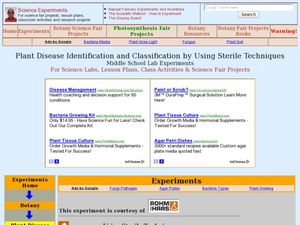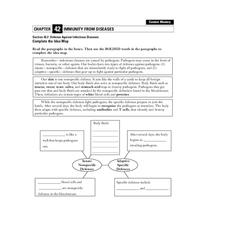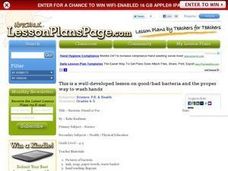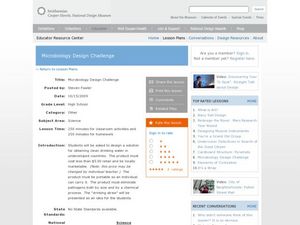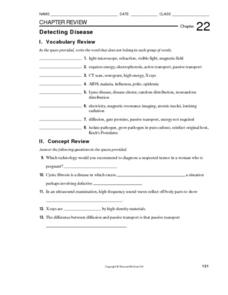Curated OER
Plant Disease Identification and Classification by Using Sterile Techniques
Seventh graders identify how to use sterile techniques when identifying plant pathogens. In this plant diseases lesson students complete a lab activity in which they see how plant diseases are identified and classified.
Curated OER
Body Battles!
Seventh graders explain the role of white blood cells in fighting infections. In this life science lesson, 7th graders create flow charts showing the immune response process. They act out and play a game to simulate actions of the immune...
Curated OER
Defense Against Infectious Diseases
In this infectious diseases instructional activity, students read about the two types of defenses the body has against pathogens: innate (nonspecific) and adaptive (specific). Students then complete a graphic organizer by filling in 11...
Curated OER
The Nature of Disease
For this disease worksheet, students read information about infectious diseases, how they are transmitted, and how they are treated. Students then complete 6 fill in the blank questions.
Curated OER
Body Defense and Disease
In this body defense and disease worksheet, students complete two multiple step questions about infectious diseases and how they are passed.
Curated OER
Antiseptic Nature of Plants
Young scholars investigate the concepts of homeostasis, competition, pathogens, and antiseptics. They conduct an experiment that compares the antiseptic properties of native plants by growing bacteria on agar plates containing plant...
Curated OER
Bacteria: Friend or Foe?
Students examine a variety of environmental and industrial roles of bacteria. explore where bacteria can be found and distinguish bacteria from other organisms.
Curated OER
What's Bugging You?
Students examine the effects of pests on other organisms, crops, and the environment. they construct an insect observation chamber and discover how some insects can be pests in some situations and beneficial in others. They write "pest...
Curated OER
Microbes and Our Food
Students investigate foodborne illnesses and involved microbes. They identify major pathogens and then research and explain how they contaminate foods and how people are affected.
Curated OER
Microorganisms
Though there are seventy-seven slides in this PowerPoint, only small bits of information are presented on each. It outlines the roles microorganisms play in the environment and spends time listing characteristics of each four different...
Curated OER
Diversity of Life: Pathogens
Learners research bacteria and viruses that carry pathogens. In this diversity lesson, students examine how pathogens spread disease through bacteria and viruses. Learners write a report on disease caused by bacteria or virus including...
Curated OER
Microbiology Design Challenge
Students discover dangers to human health by researching what's in our drinking water. In this water purification lesson, students discuss the conditions of water in undeveloped countries and why it is unsafe to drink....
Curated OER
Immunity From Diseases
In this immunity instructional activity, students review vocabulary associated with how the body defends itself from diseases. This instructional activity has 12 matching questions.
Curated OER
Preventing and Treating Disease
In this disease worksheet, students will review the organs associated with the immune system including their specific functions. This worksheet has 10 matching, 8 true or false, and 5 short answer questions.
Curated OER
Detecting Disease
In this detecting disease worksheet, students will review the different tools scientists use to identify diseases including the steps of Koch's postulates. This worksheet has 14 fill in the blank and 4 short answer questions.
Curated OER
Bacteria in Your Life
In this bacteria instructional activity, students describe the process that kills harmful bacteria in milk. Then they describe what types of bacteria are helpful to farmers and which two plants have these bacteria in their roots....
Curated OER
Communicable Diseases
In this communicable diseases activity, students explain what causes most types of diseases. Then they describe the difference between a disinfectant and an antiseptic. Students also determine ways that communicable diseases can be spread.
Curated OER
Your Immune System
In this immune system worksheet, students describe an antibody and how it functions. Then they determine sources of passive immunity and how HIV affects the immune system. Students also name defenses that the digestive system has against...
Curated OER
Skin
In this skin activity, 9th graders list the five main functions of the skin. Then they explain why a runner sweats and how many sweat glands there are in the body. Students also describe what occurs when the epidermis is slightly injured.
Curated OER
Food Safety and Quality Assurance
Young scholars identify and interpret how milk is processed and learn important concepts in food safety and quality assurance. They identify how milk is processed, the importance of food safety, and the quality assurance process....
Curated OER
Ways to Prevent the Spread of Pathogens
Fifth graders discuss the ways to prevent the spread of pathogens. In groups, they use the internet to research the ways to prevent disease from spreading. They use this information to create a poster and share the information with the...
Curated OER
Describe the Perfect Pathogen
Learners develop a pathogen based upon their knowledge of pathogens and after presenting it to the class, they then suggest ways that the pathogen might be combated. Next they identify possible physical or behavioral changes in a...
Curated OER
Making Vaccines
Students discuss the steps the American government has taken in order to protect every U.S. citizen from a bioterrorist attack and how a vaccine works. After discussion, students can create six vaccines in their own virtual laboratory.
Curated OER
Applied Evolution: How Will We Get There from Here?
High schoolers explore the basic process of natural selection and how people can manipulate that process today. The consequences of natural selection on daily life and the implications of evolutionary biology in basic and applied science...


